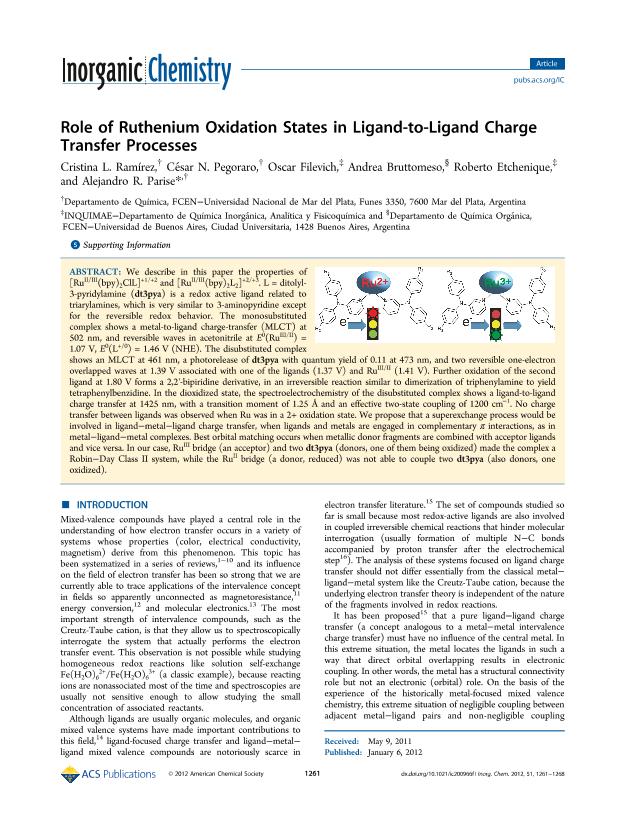Artículo
Role of Ruthenium Oxidation States in Ligand-to-Ligand Charge Transfer Processes
Ramirez, Cristina Lujan ; Pegoraro, César Nicolás
; Pegoraro, César Nicolás ; Filevich, Oscar
; Filevich, Oscar ; Bruttomesso, Andrea; Etchenique, Roberto Argentino
; Bruttomesso, Andrea; Etchenique, Roberto Argentino ; Parise, Alejandro Ruben
; Parise, Alejandro Ruben
 ; Pegoraro, César Nicolás
; Pegoraro, César Nicolás ; Filevich, Oscar
; Filevich, Oscar ; Bruttomesso, Andrea; Etchenique, Roberto Argentino
; Bruttomesso, Andrea; Etchenique, Roberto Argentino ; Parise, Alejandro Ruben
; Parise, Alejandro Ruben
Fecha de publicación:
01/2012
Editorial:
American Chemical Society
Revista:
Inorganic Chemistry
ISSN:
0020-1669
Idioma:
Inglés
Tipo de recurso:
Artículo publicado
Clasificación temática:
Resumen
We describe in this paper the properties of [RuII/III(bpy)2ClL]+1/+2 and [RuII/III(bpy)2L2]+2/+3. L = ditolyl-3-pyridylamine (dt3pya) is a redox active ligand related to triarylamines, which is very similar to 3-aminopyridine except for the reversible redox behavior. The monosubstituted complex shows a metal-to-ligand charge-transfer (MLCT) at 502 nm, and reversible waves in acetonitrile at E0(RuIII/II) = 1.07 V, E0(L+/0) = 1.46 V (NHE). The disubstituted complex shows an MLCT at 461 nm, a photorelease of dt3pya with quantum yield of 0.11 at 473 nm, and two reversible one-electron overlapped waves at 1.39 V associated with one of the ligands (1.37 V) and RuIII/II (1.41 V). Further oxidation of the second ligand at 1.80 V forms a 2,2′-bipiridine derivative, in an irreversible reaction similar to dimerization of triphenylamine to yield tetraphenylbenzidine. In the dioxidized state, the spectroelectrochemistry of the disubstituted complex shows a ligand-to-ligand charge transfer at 1425 nm, with a transition moment of 1.25 Å and an effective two-state coupling of 1200 cm–1. No charge transfer between ligands was observed when Ru was in a 2+ oxidation state. We propose that a superexchange process would be involved in ligand–metal–ligand charge transfer, when ligands and metals are engaged in complementary π interactions, as in metal–ligand–metal complexes. Best orbital matching occurs when metallic donor fragments are combined with acceptor ligands and vice versa. In our case, RuIII bridge (an acceptor) and two dt3pya (donors, one of them being oxidized) made the complex a Robin–Day Class II system, while the RuII bridge (a donor, reduced) was not able to couple two dt3pya (also donors, one oxidized).
Archivos asociados
Licencia
Identificadores
Colecciones
Articulos(CCT - MAR DEL PLATA)
Articulos de CTRO.CIENTIFICO TECNOL.CONICET - MAR DEL PLATA
Articulos de CTRO.CIENTIFICO TECNOL.CONICET - MAR DEL PLATA
Articulos(INQUIMAE)
Articulos de INST.D/QUIM FIS D/L MATERIALES MEDIOAMB Y ENERGIA
Articulos de INST.D/QUIM FIS D/L MATERIALES MEDIOAMB Y ENERGIA
Citación
Ramirez, Cristina Lujan; Pegoraro, César Nicolás; Filevich, Oscar; Bruttomesso, Andrea; Etchenique, Roberto Argentino; et al.; Role of Ruthenium Oxidation States in Ligand-to-Ligand Charge Transfer Processes; American Chemical Society; Inorganic Chemistry; 51; 1-2012; 1261-1268
Compartir
Altmétricas
Items relacionados
Mostrando titulos relacionados por título, autor y tema.
-
Burgos López, Yacelis del Socorro ; del Pla, Julian ; Balsa, Lucia Mariana ; Leon, Ignacio Esteban ; Echeverría, Gustavo Alberto ; Piro, Oscar Enrique ; García Tojal, J.; Pis Diez, Reinaldo ; Gonzalez Baro, Ana Cecilia ; Parajón Costa, Beatriz Susana (Elsevier Science Sa, 2019-03)
-
Pérez, Hiram; Ramos, Raúl; Plutín, Ana M.; Mocelo, Raúl; Erben, Mauricio Federico ; Castellano, Eduardo E.; Batista, Alzir A. (Wiley VCH Verlag, 2019-06)
-
Cornejo, María Paula ; Mustafá, Emilio Román ; Barrile, Franco ; Cassano, Daniela; de Francesco, Pablo Nicolás ; Raingo, Jesica ; Perello, Mario (Elsevier, 2020-01)



